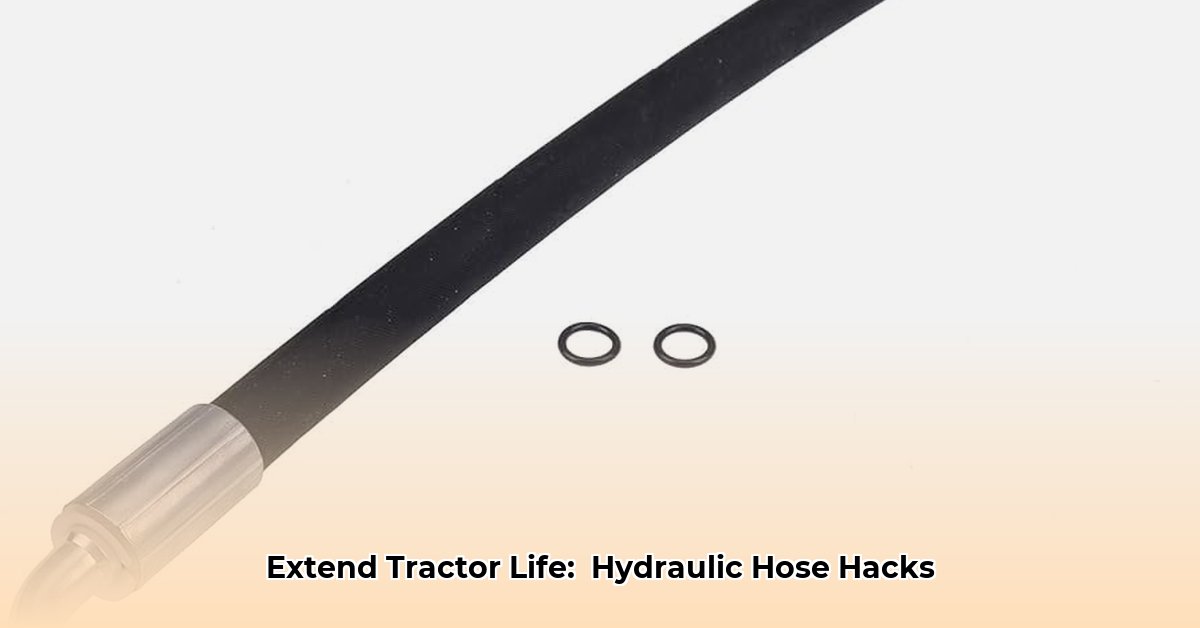
Choosing the Right Tractor Supply Hydraulic Hoses
Selecting the appropriate hydraulic hose is paramount for efficient and sustainable farming. The wrong hose can lead to costly repairs, downtime, and even safety hazards. Consider these key factors:
Pressure Rating (PSI): This indicates the maximum pressure the hose can withstand. Exceeding this limit can cause catastrophic failure. Always choose a hose with a pressure rating significantly higher than your system's maximum operating pressure. (A higher PSI rating offers a greater safety margin).
Hose Material: Different materials offer varying durability and resistance to environmental factors.
- Rubber: Cost-effective for low-pressure applications, but less durable and susceptible to damage from weather and chemicals.
- Synthetic Rubber (EPDM): More durable and resistant to weather, chemicals, and abrasion, ideal for higher-pressure systems.
- PTFE (Teflon): The most durable option, capable of withstanding extreme temperatures and corrosive fluids, but significantly more expensive.
Fittings: These connectors must be compatible with your tractor and implements to ensure a leak-free connection. Leaks waste hydraulic fluid, increase costs, and can damage equipment.
For more information on tractor supplies, check out this helpful resource.
Did you know? A single hose failure can lead to significant downtime, impacting your entire farming schedule and potentially resulting in crop losses. How much downtime can your farm afford?
Let's delve deeper into hose material selection. The following table summarizes the pros and cons of common hose materials:
| Hose Material | Pressure Rating (PSI) | Best Uses | Pros | Cons |
|---|---|---|---|---|
| Rubber | 2500 - 5000 | General-purpose, low-pressure applications | Affordable, readily available | Less durable, susceptible to weather and chemicals |
| Synthetic Rubber (EPDM) | 3000 - 6000 | High-pressure applications | More durable, weather and chemical resistant | More expensive than rubber |
| PTFE (Teflon) | Varies (often very high) | High-temperature, corrosive fluid applications | Extremely durable, resists harsh environments | Very expensive, requires specialized fittings |
Always consult your tractor's manual for specific hose recommendations.
Maintaining Your Tractor Supply Hydraulic Hoses
Regular maintenance is crucial for preventing costly repairs and ensuring optimal system performance. This contributes directly to sustainable farming by minimizing downtime and resource waste.
Your Monthly Hose Maintenance Checklist:
- Visual Inspection: Examine hoses for cracks, bulges, abrasions, or swelling. Pay close attention to the connections, as leaks often originate there.
- Connection Check: Tighten any loose fittings using the correct wrenches to avoid damage.
- Immediate Replacement: Replace any damaged hoses immediately. A compromised hose is a safety hazard and can lead to more extensive damage.
- Environmental Protection: Shield hoses from direct sunlight, extreme temperatures, and harsh chemicals. Proper storage is essential.
Fact: Regularly inspecting your hydraulic hoses can prevent up to 85% of hose-related failures, according to a study by the National Agricultural Machinery Association.
Troubleshooting Common Hydraulic Hose Problems
Identifying and addressing hydraulic hose problems quickly minimizes downtime and prevents escalating damage.
- Slow-Moving Implements: This often suggests low hydraulic pressure, potentially caused by a partially blocked hose or leak.
- Leaks: Leaks are a clear indication of damage and require immediate attention. Tighten connections first; if the leak persists, replace the hose.
- Hissing Sounds: A hissing sound indicates a leak and necessitates immediate inspection and repair.
"Ignoring a small leak today can quickly escalate into a major problem, resulting in significant downtime and expensive repairs," states Dr. Emily Carter, Agricultural Engineer at the University of California, Davis.
Sustainable Farming and Hydraulic Hoses
Proper hydraulic hose maintenance and selection directly contribute to sustainable farming practices:
- Reduced Fuel Consumption: Efficient hydraulic systems minimize fuel usage, lowering operating costs and reducing your carbon footprint.
- Precision Spraying: Precision spraying systems, controlled by hydraulics, minimize chemical waste and protect water quality.
By extending the lifespan of your hydraulic components through proper maintenance, you actively contribute to a more environmentally conscious farming operation.
Optimizing Water Usage in Hydraulic Systems
Water contamination in hydraulic systems is detrimental to both equipment performance and environmental sustainability. Here's how to address this concern:
Preventing Water Ingress
- Regular Inspections: Identify and repair leaks promptly.
- Proper Storage: Store your tractor in a dry environment to minimize condensation.
- Careful Cleaning: Avoid high-pressure washing that can force water into the system.
Detecting Water Contamination
- Sluggish Operation: Noticeably slower hydraulic responses.
- Unusual Noises: Grinding or whining sounds.
- Fluid Discoloration: Milky or cloudy hydraulic fluid.
Removing Water Contamination
- Isolate the System: Shut down and disconnect the system.
- Drain the Fluid: Completely drain the hydraulic fluid.
- Flush the System: Use fresh hydraulic fluid to flush the system repeatedly until the fluid runs clear.
- Replace Filters: Install new hydraulic filters.
- Check for Leaks: Inspect all hoses and fittings for leaks.
- Refill with Fresh Fluid: Fill with the correct type and amount of hydraulic fluid.
By implementing these maintenance strategies and practices, you'll significantly improve the health and longevity of your hydraulic system, resulting in more efficient, productive, and sustainable farming.